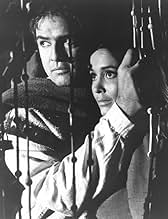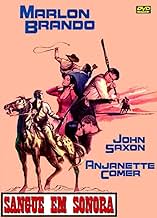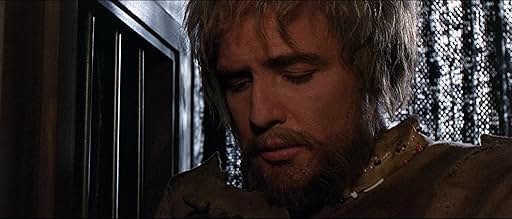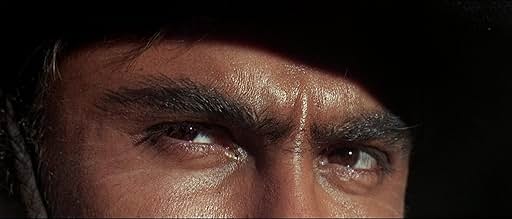IMDb RATING
6.2/10
3.8K
YOUR RATING
Man tries to recover a horse stolen from him by a Mexican bandit.Man tries to recover a horse stolen from him by a Mexican bandit.Man tries to recover a horse stolen from him by a Mexican bandit.
- Director
- Writers
- Stars
- Awards
- 1 win & 1 nomination total
Emilio Fernández
- Lazaro
- (as Emilio Fernandez)
Argentina Brunetti
- Yaqui Woman
- (uncredited)
Debra Domasin
- Paquita
- (uncredited)
Abel Fernandez
- Mexican Farmer
- (uncredited)
Raven Grey Eagle
- Minor Role
- (uncredited)
- Director
- Writers
- All cast & crew
- Production, box office & more at IMDbPro
Featured reviews
I rate this mid-60's Brando Western a 6, but it really wasn't accepted at the time. Marlon is incredible as always, Anjanette Comer is a stone fox, great supporting cast, and John Saxon as Chuy Medina is a worthy adversary to taunt Brando. Beautiful Southwest and Mexican terrain in this Sidney J. Furie flick that is well worth the trip. Similar to Joe Kidd (also with Saxon).
Best performance = Marlon Brando. Westerns of this type were on their way out by 1966, but with Brando it still makes the grade. Rafael Campos is believable as always in the most authentic way. This one is easy to find so give it a shot!
Best performance = Marlon Brando. Westerns of this type were on their way out by 1966, but with Brando it still makes the grade. Rafael Campos is believable as always in the most authentic way. This one is easy to find so give it a shot!
This film seems to be caught between the 1950s western movies and the Spaghetti Westerns later in the 60s. While the 1950s hero drawn into conflict was 'minding his own business and wanted to be left alone', once crossed the bad guy found he woke a sleeping giant. Perhaps this style was how America saw itself after Pearl Harbor.
"The Appaloosa", on the other hand, has a different style. While Brando was minding his business before being drawn into conflict, the theft of his horse occurs while he is drunk and unable handle the situation, and he seems to be inept. It is a long scene and one that ends in humiliation for Brando's character. Even if a 1950s hero was caught off guard while being drunk, he wasn't humiliated. A 1950s hero would not appear inept, just that he had made a mistake that allowed the bad guy to get the upper hand.
There are other instances in the film where Brando's character doesn't act as a 1950s hero: his ridiculous Mexican accent, his initial plan at the gang's hideout to leave with his horse, his arm-wrestling scene, his reluctance to take revenge. Brando's character was more in style of the 60s make-the-hero-more-realistic and less larger-than-life. He doesn't win all the battles. There is nothing wrong with this, as long as you interested in watching this.
I was fine with it. I did like the final gun battle as it was different from the usual face-to-face shootout.
I had problems with Brando's mumbling. His character didn't seem laconic, but someone who couldn't express himself. While he did have some good lines, other times he seemed to ramble.
The "in disguise at the bar" scene should have been cut. The conversation left me confused and the fake Mexican accent was irritating. This scene only served to introduce one of the outlaw gang members and could have been done another way.
I enjoyed the scenery, that Brando's character was a religious man without it being central to the movie, his intelligence in the final gun battle, and the motivations being believable for the conflict: the bad guy's pride and standing before his gang, and Brando's need for this horse in his future plans.
"The Appaloosa", on the other hand, has a different style. While Brando was minding his business before being drawn into conflict, the theft of his horse occurs while he is drunk and unable handle the situation, and he seems to be inept. It is a long scene and one that ends in humiliation for Brando's character. Even if a 1950s hero was caught off guard while being drunk, he wasn't humiliated. A 1950s hero would not appear inept, just that he had made a mistake that allowed the bad guy to get the upper hand.
There are other instances in the film where Brando's character doesn't act as a 1950s hero: his ridiculous Mexican accent, his initial plan at the gang's hideout to leave with his horse, his arm-wrestling scene, his reluctance to take revenge. Brando's character was more in style of the 60s make-the-hero-more-realistic and less larger-than-life. He doesn't win all the battles. There is nothing wrong with this, as long as you interested in watching this.
I was fine with it. I did like the final gun battle as it was different from the usual face-to-face shootout.
I had problems with Brando's mumbling. His character didn't seem laconic, but someone who couldn't express himself. While he did have some good lines, other times he seemed to ramble.
The "in disguise at the bar" scene should have been cut. The conversation left me confused and the fake Mexican accent was irritating. This scene only served to introduce one of the outlaw gang members and could have been done another way.
I enjoyed the scenery, that Brando's character was a religious man without it being central to the movie, his intelligence in the final gun battle, and the motivations being believable for the conflict: the bad guy's pride and standing before his gang, and Brando's need for this horse in his future plans.
The Appaloosa (1966)
** (out of 4)
Rather bizarre Western has Matt (Marlon Brando) having his horse stolen by Chuy (John Saxon) so he sets out to get him back. The two men had previous run-ins over a woman (Anjanette Comer) who will come into play as the story plays out.
THE APPALOOSA is a film that Marlon Brando didn't really want to make but the paycheck was good so he took the role. When production started he realized that he really didn't want to do the film so the shooting was somewhat of a disaster with the legend battling director Sidney J. Furie. The end result is a fairly forgettable film that tries to be something different than your typical Western.
The biggest problem with this movie is the story. In all honesty even by Western standards the story here is quite weak and would barely fill up one of those 50 minute "B" films from the 30s. We basically have the two men running into each other a couple time and the film tries to be psychological and it fails pretty bad. There are really bizarre and weird camera set-ups that are meant to be deep or to bring you into the mental state of the characters but it just doesn't work. Whatever vision director Furie was trying to bring just doesn't come across and we're left with a pretty boring movie.
The always entertaining Saxon manages to be the best thing here. With his thick Mexican accent and the paint on his face, Saxon manages to make for a fun villain but it's too bad more wasn't done with the character. I thought Corner was also good in her wasted role and especially early on when she fears for her safety after trying to break free from Chuy. As for Brando, I don't think he's bad here but it's certainly not into what he's doing. He ends up mumbling more than anything else and just doesn't bring any energy or passion to the part.
** (out of 4)
Rather bizarre Western has Matt (Marlon Brando) having his horse stolen by Chuy (John Saxon) so he sets out to get him back. The two men had previous run-ins over a woman (Anjanette Comer) who will come into play as the story plays out.
THE APPALOOSA is a film that Marlon Brando didn't really want to make but the paycheck was good so he took the role. When production started he realized that he really didn't want to do the film so the shooting was somewhat of a disaster with the legend battling director Sidney J. Furie. The end result is a fairly forgettable film that tries to be something different than your typical Western.
The biggest problem with this movie is the story. In all honesty even by Western standards the story here is quite weak and would barely fill up one of those 50 minute "B" films from the 30s. We basically have the two men running into each other a couple time and the film tries to be psychological and it fails pretty bad. There are really bizarre and weird camera set-ups that are meant to be deep or to bring you into the mental state of the characters but it just doesn't work. Whatever vision director Furie was trying to bring just doesn't come across and we're left with a pretty boring movie.
The always entertaining Saxon manages to be the best thing here. With his thick Mexican accent and the paint on his face, Saxon manages to make for a fun villain but it's too bad more wasn't done with the character. I thought Corner was also good in her wasted role and especially early on when she fears for her safety after trying to break free from Chuy. As for Brando, I don't think he's bad here but it's certainly not into what he's doing. He ends up mumbling more than anything else and just doesn't bring any energy or passion to the part.
During the peak of spaghetti westerns came this little gem with Brando at his subtle best. He plays Matt Fletcher, a Rambo like character from FIRST BLOOD who returns home for some peace and quiet. But Trini, (Anjanette), draws him into a web of jealousy and power control with the town's chief, Chuy, (John Saxon). At first it starts with a little scuffle over Matt's horse, an Appaloosa. But it digs deeper than that when morals are tested. Brando throws in the occasional modern slang that fits into this western period. It's a joy to watch him and the story slowly unravel. This will have to be director Furie's best effort with the help of Russell Metty's photography.
Yet another film from Brando's lean years; now, I only have THE UGLY American (1963; also included in Universal's "The Marlon Brando Franchise Collection") to watch from this period but, all in all, it's an underrated phase for the celebrated method actor. Incidentally, it was nice to see such long-term Universal regulars as composer Frank Skinner (SON OF FRANKENSTEIN [1939]), editor Ted Kent (BRIDE OF FRANKENSTEIN [1935]) and make-up man Bud Westmore (ABBOTT AND COSTELLO MEET FRANKENSTEIN [1948]) still involved in high profile productions such as this one after all those years. Anyway, Brando made only three Westerns in his career the others being the self-directed ONE EYED JACKS (1961) and Arthur Penn's THE MISSOURI BREAKS (1976) but they're among the more intriguing, if pretentious, from their respective eras; having said that, the film under review is easily the least rewarding of the three.
The simple plot finds aspiring rancher Brando falling foul of small-time Mexican tyrant John Saxon over the former's appaloosa stallion (later on, Saxon's girl, Anjanette Comer who does what she can with a basically underwritten role becomes the object of contention between the two); beaten up by Saxon's men and his prize horse stolen, Brando follows in pursuit ignoring the advise of friend Rafael Campos and a goat herder (Frank Silvera), he encounters on the way. Reaching the town where Saxon lives with his band of cut-throats, Brando tries to pass himself off as a local (by affecting a silly Mexican accent whose inspiration seems to have been Speedy Gonzales!); it doesn't take long for Saxon to discover his ruse and, when he does, challenges the star to a game of arm-wrestling (with a sting in its tail)! Brando loses and is beaten up again, after which Comer fed up with her own way of life takes him to Silvera's place to recover; catching up with the latter, Saxon's men kill him because he won't reveal the rancher's whereabouts but they're eliminated soon after by Brando himself. Finally, a showdown between the two parties takes place in the mountains.
Thematically, THE APPALOOSA - which celebrated film critic Pauline Kael had dismissed as "a dog of a movie about a horse" and whose title was, understandably changed to SOUTHWEST TO SONORA for its British theatrical release doesn't really cover any new ground despite Brando and director Furie's attempts to respectively infuse meaning into every gesture and shot. The latter was known for his flashy camera stylistics, and he really goes overboard here (placing characters in the extreme foreground when the main action is occurring in the remaining part of the frame including the very last shot or choosing bizarre angles such as a tilted shot during the arm-wrestling bout from the POV of a scorpion!); with this in mind, I had become even more interested in checking this one out after learning how Italian B-movie exponent Enzo G. Castellari drew on it for his impressive latter-day Spaghetti Western KEOMA (1976) on the Audio Commentary of that film's R1 Anchor Bay DVD. All of this plus Saxon's enjoyably hammy, Golden Globe-nominated performance (with an exaggerated Mexican accent to match) keeps one watching, even when the pace flags or the plot turns dreary.
Brando is said to have agreed to do this principally because he needed the cash to pay in alimony for his two ex-wives and that he quickly lost interest in the project (to the consternation of his producer and director); consequently, his contribution is atypically understated thus allowing co-star Saxon to walk away with the film! Nevertheless, the confrontation scenes between their two characters constitute definite highlights (and the climax is nicely handled kudos, in fact, to Russell Metty's cinematography throughout); otherwise, Silvera and popular Mexican actor/director Emilio Fernandez (perhaps still best-known for playing General Mapache in Sam Peckinpah's THE WILD BUNCH [1969] and here appearing as Saxon's right-hand man) are notable among the supporting cast.
The simple plot finds aspiring rancher Brando falling foul of small-time Mexican tyrant John Saxon over the former's appaloosa stallion (later on, Saxon's girl, Anjanette Comer who does what she can with a basically underwritten role becomes the object of contention between the two); beaten up by Saxon's men and his prize horse stolen, Brando follows in pursuit ignoring the advise of friend Rafael Campos and a goat herder (Frank Silvera), he encounters on the way. Reaching the town where Saxon lives with his band of cut-throats, Brando tries to pass himself off as a local (by affecting a silly Mexican accent whose inspiration seems to have been Speedy Gonzales!); it doesn't take long for Saxon to discover his ruse and, when he does, challenges the star to a game of arm-wrestling (with a sting in its tail)! Brando loses and is beaten up again, after which Comer fed up with her own way of life takes him to Silvera's place to recover; catching up with the latter, Saxon's men kill him because he won't reveal the rancher's whereabouts but they're eliminated soon after by Brando himself. Finally, a showdown between the two parties takes place in the mountains.
Thematically, THE APPALOOSA - which celebrated film critic Pauline Kael had dismissed as "a dog of a movie about a horse" and whose title was, understandably changed to SOUTHWEST TO SONORA for its British theatrical release doesn't really cover any new ground despite Brando and director Furie's attempts to respectively infuse meaning into every gesture and shot. The latter was known for his flashy camera stylistics, and he really goes overboard here (placing characters in the extreme foreground when the main action is occurring in the remaining part of the frame including the very last shot or choosing bizarre angles such as a tilted shot during the arm-wrestling bout from the POV of a scorpion!); with this in mind, I had become even more interested in checking this one out after learning how Italian B-movie exponent Enzo G. Castellari drew on it for his impressive latter-day Spaghetti Western KEOMA (1976) on the Audio Commentary of that film's R1 Anchor Bay DVD. All of this plus Saxon's enjoyably hammy, Golden Globe-nominated performance (with an exaggerated Mexican accent to match) keeps one watching, even when the pace flags or the plot turns dreary.
Brando is said to have agreed to do this principally because he needed the cash to pay in alimony for his two ex-wives and that he quickly lost interest in the project (to the consternation of his producer and director); consequently, his contribution is atypically understated thus allowing co-star Saxon to walk away with the film! Nevertheless, the confrontation scenes between their two characters constitute definite highlights (and the climax is nicely handled kudos, in fact, to Russell Metty's cinematography throughout); otherwise, Silvera and popular Mexican actor/director Emilio Fernandez (perhaps still best-known for playing General Mapache in Sam Peckinpah's THE WILD BUNCH [1969] and here appearing as Saxon's right-hand man) are notable among the supporting cast.
Did you know
- TriviaAccording to co-star John Saxon, Marlon Brando's relationship with director Sidney J. Furie got to the point where Brando, when getting ready to do a close-up, would be reading a book. He would only lower the book when Furie yelled "Action." When he yelled "Cut," Brando would raise the book again. According to Peter Manso's book on Brando, however, Brando and Furie met years later. Brando was quoted to have said, "I thought you were a no-good double-crosser, and I didn't know if I could trust you, but I saw the film and you have the great sense of the best visual directors. Let's do another movie together." Furie, according to the book, replied, "Never!" Furie, for his part, claims that they only came to blows once on the entire shoot of The Appaloosa (1966).
- GoofsThe Appaloosa which portrays the title character was actually a registered Appaloosa stallion named Cojo Rojo. He was born in 1960 and just prior to being used for the film he was racing on the California tracks. He sired several foals, including several race champions. During filming a few other similarly marked horses were used as stunt horses, but the majority of work was done by Cojo Rojo.
- Quotes
[first lines]
Priest: Madam.
[enters confessional booth]
Matt Fletcher: I'm having a little trouble getting started, Father.
Priest: You are in the House of God now, my son. Speak from your heart.
Matt Fletcher: Well, I've done a lot of killin'. I've killed a lot of men and sinned a lot of women. But the men I killed needed killin' and the women wanted sinnin', and well, I never was one much to argue.
- ConnectionsReferenced in Stalingrad (2001)
- How long is The Appaloosa?Powered by Alexa
Details
- Runtime1 hour 38 minutes
- Color
- Aspect ratio
- 2.35 : 1
Contribute to this page
Suggest an edit or add missing content































